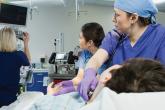Article

Big data ready to revolutionize infectious diseases research
- Author:
- Jessica Craig
Most researchers and public health experts believe big data may be poised to revolutionize the field of infectious diseases research.
Article

REBOA may be a safe alternative to RTACC in the acute care setting
- Author:
- Jessica Craig
WASHINGTON – Resuscitative endovascular balloon occlusion of the aorta (REBOA) could be an acceptable alternative to thoracotomy in traumatic...
Article
How to Tweet: a guide for physicians
- Author:
- Jessica Craig
Article

Ustekinumab leads to high 6-week clinical response and 44-week remission rates
- Author:
- Jessica Craig
Intravenous induction of ustekinumab induced high 6-week clinical response and 44-week remission rates in patients with moderately to severely...
Article

Simulation model favors hernia surgery over watchful waiting
- Author:
- Jessica Craig
Surgical repair of ventral hernias at time of diagnosis is a more cost-effective approach than watchful waiting, according to the results of a...
Article

FDA approves tenofovir alafenamide for patients with chronic hepatitis B and liver disease
- Author:
- Jessica Craig
FDA has approved tenofovir alafenamide (marketed as Vemlidy by Gilead Sciences) for the treatment of adults with chronic hepatitis B virus...
Article

High protein intake moderately associated with improved breast cancer survival
- Author:
- Jessica Craig
Higher protein intake, particularly protein from animal sources, is associated with a modest but lower risk of breast cancer recurrence and death...
Article

Tobacco-related cancer incidence, mortality drop
- Author:
- Jessica Craig
Tobacco-related cancer incidence and mortality rates dropped from 2004 to 2013, the Centers for Disease Control and Prevention reported in the...
Article

New criteria estimate systemic sclerosis to be more prevalent in primary biliary cholangitis patients
- Author:
- Jessica Craig
The use of outdated criteria for the identification of systemic sclerosis in primary biliary cholangitis likely led to an underestimation of the...
Article

ASCO: Patients with advanced cancer should receive palliative care within 8 weeks of diagnosis
- Author:
- Jessica Craig
Patients should be referred to interdisciplinary palliative care teams within 8 weeks of cancer diagnosis, and palliative care should be available...
Article

2014-2015 influenza vaccine ineffective against predominant strain
- Author:
- Jessica Craig
The 2014-2015 influenza vaccines offered little protection against the predominant influenza A/H3N2 virus, but were effective against influenza B...
Article

Dengue vaccine beneficial only in moderate to high transmission settings
- Author:
- Jessica Craig
Seropositive pediatric patients benefit from dengue virus vaccination, but vaccination of seronegative patients leads to an increased risk for...
Article

Unexplained subfertility in RA linked to periconceptional NSAID use
- Author:
- Jessica Craig
Women with rheumatoid arthritis are more often diagnosed with unexplained subfertility, compared with women in the general population, according...
Article

Overdiagnosis more likely than early detection of threatening cancer with mammography screening
- Author:
- Jessica Craig
Following the introduction of mammography, women were considerably more likely to have tumors that were overdiagnosed than to have earlier...
Article

CDC: Improvement in breast cancer mortality slower among black women
- Author:
- Jessica Craig
Breast cancer mortality rates decreased for both white and black women from 2000 to 2014, but the decrease was slower for black women.
